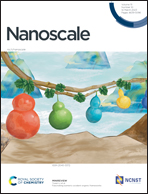Molecular relays in nanometer-scale alumina: effective encapsulation for water-submersed halide perovskite photocathodes†
Abstract
Halide perovskite (HaP) solar cells have an excellent voltage efficiency (>70%) and a low electron-affinity conduction band minimum, making them prospective candidates to be used as photocathodes in integrated low-cost solar fuel generators. However, halide perovskites are notoriously unstable in aqueous solutions and immediately dissolve upon exposure to water. Ultrathin layers (<10 nm) of Al2O3 deposited by atomic layer deposition are suitable encapsulants to prevent water ingression but are also electronically insulating. Embedding linear conjugated organic molecules (‘molecular relays’) that transverse the insulating layer enables selective electron transport across the insulating encapsulating layer. The electronic functionality of the embedded molecular relays is verified by conductive probe atomic force microscopy and photoelectrodeposition of metal particles (Pt and Ag) from ethanolic solutions. Lastly, the encapsulated HaP photoelectrodes were submersed in a CO2-saturated aqueous electrolyte and a photocurrent of ∼100 μA cm−2 (at ∼−0.32 V vs. Ag/AgCl) was measured, the highest reported for CsPbBr3 based aqueous photoelectrodes. This work demonstrates a way for stabilizing perovskite semiconductors in polar and protonic electrolytes as photoelectrodes for the generation of solar fuels.



 Please wait while we load your content...
Please wait while we load your content...